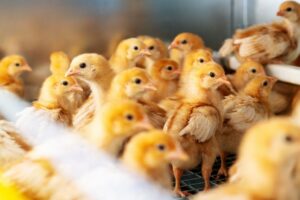You need to plant a survival forest to supplement your long term food supply and ensure that your family has the nutritious foods that they need to help them survive the challenges in our future.
You can grow a productive food forest whether you live on a quarter-acre or five acres. These principles can be applied to large and small scale backyards … or even front yards.
Chickens play an important role in the survival food forest. Do you want to raise chickens with very little smell and almost not work? The best way to feed and care for a flock of laying hens is to intentionally create a sustainable habitat that provides all of the chicken’s basic needs.
In turn, those chickens happily work constantly and reduce the amount of labor that we need to contribute in order to produce our own food. This fantastic reality is our Backyard Survival Food Forest.
Our well-designed backyard food forest creates a sustainable ecosystem that:
1. Creates an ideal habitat for healthy chickens
2. Produces a substantial portion of the chicken’s daily diet
3. Reduces or almost eliminates odors
4. Yields eggs of high nutritional content
5. Considerably reduces human labor input
6. Provides an abundance of organic fresh fruit throughout the growing season
7. Turns raising chickens into an enjoyable, relaxing pastime
We have had a little flock of backyard chickens for many years. We have made many mistakes and learned valuable lessons in the process. In this post, we will share with you our perfect solution for a sustainable food source that you can create in your own backyard that your family can enjoy every day as well as depend on as a survival food source when life gets tough.
To learn more about creating your own survival food forest visit our post:
How to Create a Survival Food Forest in Your Own Backyard
https://theprovidentprepper.org/how-to-create-a-survival-food-forest-in-your-own-backyard/
A survival food forest provides you with fresh produce along with eggs that are rich in both critical fats and protein that will complement the foods that you have stored in your long term food supply. This long term food supply should be rich in grains, beans and other staples that will ensure you have the calories and balanced nutrition to keep your family well-fed and healthy regardless of the challenges you may need to face.
Learn more about building your long term food supply at:
How to build a long term food supply
https://theprovidentprepper.org/long-term-food-storage-creative-solutions-to-build-a-critical-asset/
———————————————
Our friend, Tom Bartels, is a master organic gardener. If you are ready to get serious about growing your own food in your backyard check out Tom’s incredible workshops at:
https://growfoodwell.lpages.co/springcovidpro/
Once you understand how to “Align the Design” of your garden with what plants actually need to thrive, you’ll work half as much, while getting twice the yields. Tom Bartels from GrowFoodWell.com is giving away some of his best secrets for growing carrots, nutrient-dense greens, and is offering a major discount on his video workshops to help home gardeners in this difficult time.
I consider myself a skilled gardener. This year our ability to grow our own food matters more than ever. Jonathan and I decided to purchase Tom’s class to see if we could learn tips to help ensure our success. It was a great investment. The classes are incredible!
We were so impressed that we contacted Tom and asked if we could work with him to help get this class to our viewers. It was worth every penny that we paid for it. Seriously, if you want to learn how to grow your own food in your backyard successfully and inexpensively, this class is worth your time and every penny!
Thanks for being part of the solution!
View original video here






















